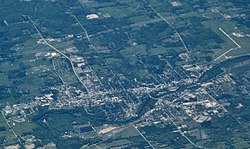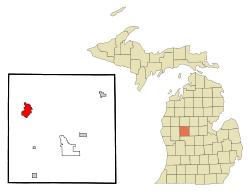Big Rapids, Michigan
City in Michigan, United States From Wikipedia, the free encyclopedia
City in Michigan, United States From Wikipedia, the free encyclopedia
Big Rapids is a city and the seat of government of Mecosta County, Michigan. The population was 7,727 at the 2020 census,[2] down from 10,601 in 2010.[5] The city is surrounded by Big Rapids Charter Township but they are completely separate jurisdictions. Big Rapids is home of the main campus of Ferris State University, a four-year public university.
Big Rapids, Michigan | |
|---|---|
 Aerial photograph of Big Rapids in 2009 | |
 Location of Big Rapids, Michigan | |
| Coordinates: 43°41′56″N 85°28′52″W | |
| Country | |
| State | |
| County | Mecosta |
| Area | |
| • Total | 4.56 sq mi (11.82 km2) |
| • Land | 4.45 sq mi (11.51 km2) |
| • Water | 0.12 sq mi (0.30 km2) |
| Elevation | 925 ft (282 m) |
| Population | |
| • Total | 7,727 |
| • Density | 1,738.36/sq mi (671.13/km2) |
| Time zone | UTC-5 (Eastern (EST)) |
| • Summer (DST) | UTC-4 (EDT) |
| ZIP code | 49307 |
| Area code | 231 |
| FIPS code | 26-08300[3] |
| GNIS feature ID | 1619197[4] |
| Website | cityofbr |
Big Rapids was settled in 1855 by brothers George and Zera French. As the village of Leonard, at the intersection of Elm and Stewart streets, it became the seat of Mecosta County on February 11, 1859,[6] but local lumbermen knew the site as Big Rapids. On September 29, 1859, the Leonard post office was renamed Big Rapids.[6] Big Rapids was platted on November 3, 1859, surrounding the courthouse site of Leonard.[6] The unincorporated community of Big Rapids was first cited on June 10, 1861, rather than Leonard, when the Mecosta County board of supervisors mentioned their seat of government, and in 1865 was consistently cited throughout the year.[6] Big Rapids was incorporated as a city in 1869.[6][7]
Big Rapids is in northwestern Mecosta County in central Michigan. It is 56 miles (90 km) north of Grand Rapids and 42 miles (68 km) south of Cadillac, both via U.S. Route 131. The city sits along the Muskegon River, which passes Ferris State University and the local middle school on its way southwest to Lake Michigan. As with most of the area, Big Rapids lies on an ancient sea bed and has a sandy subsoil which lies above an iron ore base.
According to the United States Census Bureau, the city has a total area of 4.56 square miles (11.81 km2), of which 4.45 square miles (11.53 km2) are land and 0.12 square miles (0.31 km2), or 2.56%, are water.[1]
The city levies an income tax of 1 percent on residents and 0.5 percent on nonresidents.[8]
The Fred Meijer White Pine Trail, a 92-mile (148 km) multi-use trail from Grand Rapids to Cadillac, passes through Big Rapids.
Big Rapids' population peaked in the 1980s. Since the 1980s, Big Rapids has lost over 46% of its population.[3] There are a number of reasons for the decline, one being the decline in enrollment at Ferris State University.[11] Quality of life concerns have also played a role. Mecosta County (like most rural areas)[12] struggles with poor education, lack of high-paying jobs, and high rates of substance abuse.[13]
As of the census of 2020, there were 7,727 people, 3,085 households, and 1,044 families living in the city. The population density was 1,738.4 inhabitants per square mile (671.2/km2). There were 3,590 housing units at an average density of 806.7 inhabitants per square mile (311.5/km2). The racial makeup of the city was 83% White, 5.8% African American, 0.5% Native American, 2.1% Asian, 1.4% from other races, and 7.2% from two or more races. Hispanic or Latino residents of any race were 5.1% of the population.
There were 3,085 households, of which 22.3% had children under the age of 18 living with them, 21.5% were married couples living together, 10% had a female householder with no husband present, 2.4% had a male householder with no wife present, and 66.2% were non-families. 42.3% of all households were made up of individuals, and 13.5% had someone living alone who was 65 years of age or older. The average household size was 2.09 and the average family size was 2.91.
The median age of the city was 22 years. 12.8% of residents were under the age of 18; 51.2% were between the ages of 18 and 24; 17.6% were from 25 to 44; 10.7% were from 45 to 64; and 7.7% were 65 years of age or older. The gender makeup of the city was 53.7% male and 46.3% female.
As of the census[14] of 2010, there were 10,601 people, 3,330 households, and 1,323 families living in the city. The population density was 2,431.4 inhabitants per square mile (938.8/km2). There were 3,623 housing units at an average density of 831.0 per square mile (320.9/km2). The racial makeup of the city was 88.0% White, 6.8% African American, 0.7% Native American, 1.5% Asian, 0.6% from other races, and 2.5% from two or more races. Hispanic or Latino residents of any race were 2.4% of the population.
There were 3,330 households, of which 22.2% had children under the age of 18 living with them, 22.9% were married couples living together, 12.7% had a female householder with no husband present, 4.2% had a male householder with no wife present, and 60.3% were non-families. 36.5% of all households were made up of individuals, and 9.8% had someone living alone who was 65 years of age or older. The average household size was 2.22 and the average family size was 2.88.
The median age in the city was 21.8 years. 12.5% of residents were under the age of 18; 54% were between the ages of 18 and 24; 15.9% were from 25 to 44; 11.2% were from 45 to 64; and 6.5% were 65 years of age or older. The gender makeup of the city was 51.0% male and 49.0% female.
This climatic region has large seasonal temperature differences, with warm to hot (and often humid) summers and cold (sometimes severely cold) winters. According to the Köppen Climate Classification system, Big Rapids has a humid continental climate, abbreviated "Dfb" on climate maps.[15]
| Climate data for Big Rapids Water Treatment Plant, Michigan (1991–2020 normals, extremes 1896–present) | |||||||||||||
|---|---|---|---|---|---|---|---|---|---|---|---|---|---|
| Month | Jan | Feb | Mar | Apr | May | Jun | Jul | Aug | Sep | Oct | Nov | Dec | Year |
| Record high °F (°C) | 61 (16) |
64 (18) |
85 (29) |
89 (32) |
93 (34) |
99 (37) |
103 (39) |
101 (38) |
97 (36) |
88 (31) |
76 (24) |
66 (19) |
103 (39) |
| Mean daily maximum °F (°C) | 28.2 (−2.1) |
31.4 (−0.3) |
42.0 (5.6) |
54.8 (12.7) |
67.6 (19.8) |
77.2 (25.1) |
81.3 (27.4) |
79.0 (26.1) |
71.6 (22.0) |
58.1 (14.5) |
44.1 (6.7) |
33.2 (0.7) |
55.7 (13.2) |
| Daily mean °F (°C) | 20.4 (−6.4) |
21.8 (−5.7) |
30.9 (−0.6) |
42.9 (6.1) |
55.4 (13.0) |
65.1 (18.4) |
69.2 (20.7) |
67.0 (19.4) |
59.3 (15.2) |
47.2 (8.4) |
35.8 (2.1) |
26.3 (−3.2) |
45.1 (7.3) |
| Mean daily minimum °F (°C) | 12.7 (−10.7) |
12.2 (−11.0) |
19.8 (−6.8) |
30.9 (−0.6) |
43.2 (6.2) |
53.0 (11.7) |
57.1 (13.9) |
55.0 (12.8) |
46.9 (8.3) |
36.3 (2.4) |
27.5 (−2.5) |
19.3 (−7.1) |
34.5 (1.4) |
| Record low °F (°C) | −30 (−34) |
−36 (−38) |
−24 (−31) |
1 (−17) |
20 (−7) |
28 (−2) |
32 (0) |
32 (0) |
16 (−9) |
10 (−12) |
−8 (−22) |
−18 (−28) |
−36 (−38) |
| Average precipitation inches (mm) | 2.43 (62) |
1.97 (50) |
2.57 (65) |
3.95 (100) |
3.76 (96) |
3.36 (85) |
3.48 (88) |
4.24 (108) |
3.02 (77) |
3.76 (96) |
3.05 (77) |
2.33 (59) |
37.92 (963) |
| Average snowfall inches (cm) | 17.8 (45) |
16.0 (41) |
7.7 (20) |
1.5 (3.8) |
0.0 (0.0) |
0.0 (0.0) |
0.0 (0.0) |
0.0 (0.0) |
0.0 (0.0) |
0.2 (0.51) |
3.8 (9.7) |
14.3 (36) |
61.3 (156) |
| Average precipitation days (≥ 0.01 in) | 16.5 | 12.9 | 11.6 | 13.5 | 13.0 | 10.7 | 10.5 | 11.3 | 11.5 | 14.7 | 13.7 | 14.9 | 154.8 |
| Average snowy days (≥ 0.1 in) | 13.8 | 10.0 | 5.1 | 1.4 | 0.0 | 0.0 | 0.0 | 0.0 | 0.0 | 0.2 | 3.4 | 9.8 | 43.7 |
| Source: NOAA[16][17] | |||||||||||||
Seamless Wikipedia browsing. On steroids.
Every time you click a link to Wikipedia, Wiktionary or Wikiquote in your browser's search results, it will show the modern Wikiwand interface.
Wikiwand extension is a five stars, simple, with minimum permission required to keep your browsing private, safe and transparent.